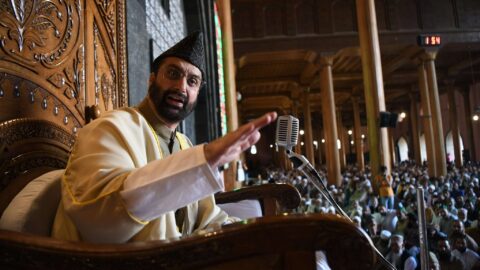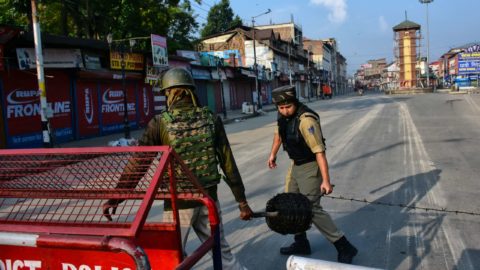On December 27th, Mirwaiz Muhammad Umar Farooq, was barred from leaving his house to lead…
Unsung Kashmiri Muslim heroes of world’s first labor movement
By Iftikhar Gilani, first published at Muslim Network TV
This overlooked chapter in the history of the labor movement goes back not only to the Haymarket protests but also recalls the universal and ongoing struggle for workers’ rights.
As the world celebrates Labor Day, or May Day (minus U.S. and Canada), on Wednesday, remembering the historic 1886 protests in Chicago’s Haymarket Square, it is important to remember that labor activism has deeper, lesser-known roots.
Nearly 21 years earlier, on April 29, 1865, a significant but largely overlooked labor uprising occurred in Srinagar, the summer capital of Jammu and Kashmir. This event marks perhaps the first organized labor and trade union movement in the world and predates even the well-known struggles that led to the international recognition of workers’ rights.
It is believed that since the workers were Muslims, the left movement activists or communists showed no sympathy for these hapless victims. Only late trade union leader and journalist, Pran Nath Jalali, used to mark this day by inviting friends for a cup of tea at the Press Club of India in New Delhi to observe this day during his lifetime.
On this spring day in 1865, weavers and other workers in the shawl industry protested in Srinagar against the oppressive taxation and poor working conditions under the Hindu Dogra rulers.
The protests were brutally crushed, leaving at least 28 poor Muslim workers dead and hundreds injured – a poignant moment of sacrifice in the history of the labor movement.
Cashmere shawls, especially the pashmina (also known as cashmere in Europe), have long been famous worldwide, fetching high prices and becoming a symbol of status and fashion in Europe.
Historical figures such as Napoleon Bonaparte have been associated with these luxurious items, and his wife Josephine is said to have owned up to 60 cashmere shawls. The Mughal emperors of India were also fond of these shawls, which they often gave as gifts to foreign dignitaries, increasing their popularity in Europe.
Despite their international reputation, the artisans who made these shawls lived in squalid conditions.
The Treaty of Amritsar of 1846, which established Dogra Hindu rule under King Gulab Singh under British suzerainty, stipulated annual tributes to the British, including pashmina shawls.
Article 10 of the treaty states: “Maharaja Gulab Singh acknowledges the suzerainty of the British Government and as a token of this suzerainty will give to the British Government annually one horse, twelve billy goats of recognized breeds (six males and six females) and three pairs of cashmere shawls.”
This treaty symbolized the external and internal pressures on Kashmir, where local rulers imposed harsh taxes on production and ensured that weavers were impoverished and effectively bound to their looms as serfs.
The tax system under the Dogra rule was punitive.
-Punitive taxation
Mridu Rai, author of the book “Hindu Rulers, Muslim Subjects: Islam, Rights, and the History of Kashmir”,” describes the tax system introduced by the Hindu Dogra rulers in the region as leaving the Muslim Kashmiri laborers with only the bare necessities of life.
In addition to economic exploitation, social controls prevented the weavers from leaving the region or changing their profession as they faced severe penalties, including the arrest of their families and confiscation of their property.
The production of silk, saffron, paper, tobacco, wine, and salt was a state monopoly. A levy of 85% was imposed on all wool producers.
Under these miserable working conditions, a shawl weaver could barely earn seven rupees ($0.092) a month. From these earnings, the workers had to pay five rupees (0.066 dollars) as tax, as the British army officer Lord Birdwood noted.
The amount left to the laborers also included the cost of wool, etc., and they could not afford to buy grains or vegetables and ate only water chestnuts to maintain a connection to the soul.
“The cloth weavers were not allowed to leave Kashmir or change their occupation so they were almost in the position of slaves. The Hindu ruler feared that the emigration of the weavers would reduce his income,” writes the European traveler Andrew Wilson in his book The Abode of Snow: Observations on a Journey from Chinese Tibet to the Indian Caucasus through the Upper Valleys of the Himalaya. He had visited the region in 1873.
The special tax department called Daag-e-shawl was known for arbitrarily collecting exorbitant taxes for the ruler and regulating the work of weavers with factory owners or proprietors.
“If a weaver left work, the Daag-e-shawl arrested his wife, children, and parents and confiscated his house,” the book says.
A new practice was also introduced whereby the ruler auctioned off this section to a contractor, who in turn collected the taxes.
In 1865, the ruler awarded this office to a wealthy Kashmiri, Raj Kak Dhar, and received 2 million rupees ($26,402) in return.
“This left Dhar completely free to realize this amount through arbitrarily fixed tax rates and the use of soldiers to poach workers,” says historian Mohammad Yusuf Saraf.
In 1865, nearly 125,000 people in Kashmir were associated with this trade, including weavers, washermen, and other skilled laborers.
According to tax records, this industry brought in 5 million rupees (6,594 dollars) annually – a handsome sum in the 19th century.
-Day of protest
Their patience had run out. So on April 29, 1865, the weavers marched against the high taxation and miserable working conditions and demanded nominal wages. They also demanded an end to the ban on their emigration and the ban on taking up another profession. They also requested a meeting with the Diwan, a representative of the ruler in Srinagar.
However, a column of the Dogra army under Colonel Bije Singh stopped them at the narrow Haji Pather bridge over the river Jhelum. Historians have recorded that 28 improvised unarmed weavers were thrown into the river during the stampede and scores of people were injured by gunfire.
“The next day, the bodies were recovered from the river and paraded by the weavers to attract the attention of the ruler. The organizers of the procession were stopped and arrested and even flogged,” says Rekha Chowdary, a teacher at the University of Jammu.
Rasool Sheikh, Ali Pal, Abdul Qudus, and Sona Shah — the leaders who had led the procession – were detained in Bahu Fort jail in the Jammu region.
They never returned to Kashmir and died in jail. No inquiry was ever initiated, nor was a memorial ever dedicated to the world’s first trade union movement, which took place long before the Chicago incident or even before the Russian or Chinese communist revolutions, which were a result of workers’ resistance to exploitation.
This overlooked chapter in the labor union history not only predates the Haymarket protests but is also a poignant reminder of the universal and ongoing struggle for workers’ rights.
On the occasion of World Labor Day, reflecting on such forgotten movements enriches our understanding of the roots of the global labor movement and the ongoing struggle for justice and recognition that continues in many parts of the world today.




